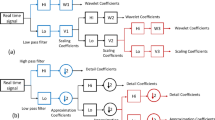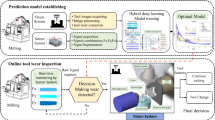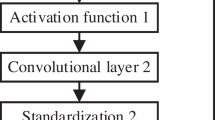Abstract
In order to solve the problem of untimely monitoring of tool wear status during laser-ultrasonic compound cutting (LUCC), which leads to the reduction of process accuracy and product quality damage, a method of tool wear status monitoring based on acoustic emission (AE) and deep learning is proposed in this paper. The AE signal is collected and analyzed in the frequency and time-frequency domains by using Fourier transform (FT) and wavelet packet decomposition (WPD), it is found that the AE signal energy is mainly concentrated in the 1st, 2nd, 3rd, and 4th frequency bands, and the energy of each frequency band in the signal increases gradually when the tool wear degree increases, however, the percentage of energy of each frequency band in the total energy shows different change trend. According to the amount of flank wear of the tool, the tool wear degree is divided into four tool wear states. The SVM model and BP neural network model were established based on MATLAB software to realize the tool wear state monitoring. The results show that the tool wear monitoring based on BP neural network is better than that of SVM for tool wear status monitoring. The model identification correct rate reaches 99 %, which is more suitable for the tool wear state monitoring designed in this paper.
Similar content being viewed by others
References
J. Dominguez-Caballero, S. Ayvar-Soberanis, J. Kim, A. Roy, L. Li and D. Curtis, Hybrid simultaneous laser- and ultrasonic-assisted machining of Ti-6Al-4V alloy, The International Journal of Advanced Manufacturing Technology, 125(3–4) (2023) 1903–1916.
P. C. Peng, D. H. Xiang, Y. Q. Li, Z. J. Yuan, X. F. Lei, B. Li, G. F. Liu, B. Zhao and G. F. Gao, Experimental study on laser assisted ultrasonic elliptical vibration turning (la-uevt) of 70 % Sicp/Al composites, Ceram. Int., 48(22) (2022) 33538–33552.
Z. G. Liu, X. Z. Jin, J. Y. Zhang, Z. J. Hao and J. H. Li, Design optimization and eigenfrequency tuning of ultrasonic oscillator of one-dimensional longitudinal vibration at high temperature for laser welding, The International Journal of Advanced Manufacturing Technology, 119(5–6) (2022) 4011–4029.
Y. N. Cheng, X. Y. Gai, R. Guan, Y. B. Jin, M. D. Lu and Y. Ding, Tool wear intelligent monitoring techniques in cutting: a review, Journal of Mechanical Science and Technology, 37(1) (2023) 289–303.
J. W. Zhao, S. J. Guo, L. Ma, H. Q. Kong and N. Zhang, Tool wear monitoring based on an improved convolutional neural network, Journal of Mechanical Science and Technology, 37(4) (2023) 1949–1958.
Q. Q. Wang, Z. J. Jin, Y. Zhao, L. Niu and J. Guo, A comparative study on tool life and wear of uncoated and coated cutting tools in turning of tungsten heavy alloys, Wear, 482–483 (2021) 203929.
M. Castejón, E. Alegre, J. Barreiro and L. K. Hernández, Online tool wear monitoring using geometric descriptors from digital images, International Journal of Machine Tools and Manufacture, 47(12–13) (2007) 1847–1853.
K. P. Zhu, H. Guo, S. Li and X. Lin, Online tool wear monitoring by super-resolution based machine vision, Computers in Industry, 144 (2023) 103782.
R. G. Lins, P. R. Marques de Araujo and M. Corazzim, Inprocess machine vision monitoring of tool wear for cyberphysical production systems, Robotics and Computer-Integrated Manufacturing, 61 (2020) 101859.
B. Y. Zhang, T. Y. Sui, B. Lin, W. Zheng, S. P. Li, S. Fang, Y. Huang and Y. Q. Feng, Drilling process of cf/sic ceramic matrix composites: cutting force modeling, machining quality and pcd tool wear analysis, Journal of Materials Processing Technology, 304 (2022) 117566.
I. S. Kang, J. S. Kim and Y. W. Seo, Cutting force model considering tool edge geometry for micro end milling process, Journal of Mechanical Science and Technology, 22(2) (2008) 293–299.
X. B. Jing, R. Y. Lv, Y. Chen, Y. L. Tian and H. Z. Li, Modelling and experimental analysis of the effects of run out, minimum chip thickness and elastic recovery on the cutting force in micro-end-milling, International Journal of Mechanical Sciences, 176 (2020) 105540.
D. H. Kim, J. Y. Song, S. K. Cha and H. G. Son, The development of embedded device to detect chatter vibration in machine tools and cnc-based autonomous compensation, Journal of Mechanical Science and Technology, 25(10) (2011) 2623–2630.
P. F. Zhang, D. Gao, Y. Lu, Z. F. Ma, X. R. Wang and X. Song, Cutting tool wear monitoring based on a smart toolholder with embedded force and vibration sensors and an improved residual network, Measurement, 199 (2022) 111520.
M. C. Gomes, L. C. Brito, M. Bacci Da Silva and M. A. Viana Duarte, Tool wear monitoring in micromilling using support vector machine with vibration and sound sensors, Precision Engineering, 67 (2021) 137–151.
Q. Pan, R. Zhou, J. Y. Su, T. He and Z. B. Zhang, Automatic localization of the rotor-stator rubbing fault based on acoustic emission method and higher-order statistics, Journal of Mechanical Science and Technology, 33(2) (2019) 513–524.
J. Bhaskaran, M. Murugan, N. Balashanmugam and M. Chellamalai, Monitoring of hard turning using acoustic emission signal, Journal of Mechanical Science and Technology, 26(2) (2012) 609–615.
C. D. Wang, Z. L. Bao, P. Q. Zhang, W. W. Ming and M. Chen, Tool wear evaluation under minimum quantity lubrication by clustering energy of acoustic emission burst signals, Measurement, 138 (2019) 256–265.
P. Twardowski, M. Tabaszewski, M. Wiciak Pikuła and A. Felusiak-Czyryca, Identification of tool wear using acoustic emission signal and machine learning methods, Precision Engineering, 72 (2021) 738–744.
M. Kuntoğlu and H. Sağlam, Investigation of signal behaviors for sensor fusion with tool condition monitoring system in turning, Measurement, 173 (2021) 108582.
E. Kuljanic and M. Sortino, Twem, a method based on cutting forces—monitoring tool wear in face milling, International Journal of Machine Tools and Manufacture, 45(1) (2005) 29–34.
B. S. Prasad and M. P. Babu, Correlation between vibration amplitude and tool wear in turning: numerical and experimental analysis, Engineering Science and Technology, An International Journal, 20(1) (2017) 197–211.
L. S. Zuo, D. W. Zuo, Y. C. Zhu and H. F. Wang, Acoustic emission analysis for tool wear state during friction stir joining of sicp/al composite, The International Journal of Advanced Manufacturing Technology, 99(5–8) (2018) 1361–1368.
X. X. Sun, Y. Zhao, W. J. Meng and Y. Y. Zhai, Research on average vertical velocity of rubber particles in vertical screw conveyor based on bp neural network, Journal of Mechanical Science and Technology, 35(11) (2021) 5107–5116.
Y. Liu, X. F. Wang, X. G. Zhu and Y. Zhai, Thermal error prediction of motorized spindle for five-axis machining center based on analytical modeling and bp neural network, Journal of Mechanical Science and Technology, 35(1) (2021) 281–292.
Z. H. Wang, Q. Q. Chen, Z. Y. Wang and J. Xiong, The investigation into the failure criteria of concrete based on the bp neural network, Engineering Fracture Mechanics, 275 (2022) 108835.
S. J. Zhou, C. Liu, Y. E. Zhao, G. Z. Zhang and Y. L. Zhang, Leakage diagnosis of heating pipe-network based on bp neural network, Sustainable Energy, Grids and Networks, 32 (2022) 100869.
M. H. Du, P. X. Wang, J. H. Wang, Z. Cheng and S. S. Wang, Intelligent turning tool monitoring with neural network adaptive learning, Complexity, 2019 (2019) 1–21.
Y. W. Xu, L. Gui and T. C. Xie, Intelligent recognition method of turning tool wear state based on information fusion technology and bp neural network, Shock And Vibration, 2021 (2021) 1–10.
Y. X. Mao, M. Z. Zheng, T. Q. Wang and M. L. Duan, A new mooring failure detection approach based on hybrid lstm-svm model for semi-submersible platform, Ocean Engineering, 275 (2023) 114161.
G. X. Wu, J. W. Zhang, G. F. Li, L. L. Wang, Q. Yu and J. M. Guo, Identification method of nonlinear maneuver model for unmanned surface vehicle from sea trial data based on support vector machine, Journal of Mechanical Science and Technology, 36(8) (2022) 4257–4267.
J. C. Jiang, R. H. Zhang, Y. T. Wu, C. Chang and Y. Jiang, A fault diagnosis method for electric vehicle power lithium battery based on wavelet packet decomposition, Journal of Energy Storage, 56 (2022) 105909.
C. J. Zhang, J. C. Hu, Z. Y. Wang and Y. J. Cao, Wear study of CBN tools in laser ultrasonic composite cutting of cemented carbide, P. I. Mech. Eng. C-J Mec., 238(7) (2024) 2734–2744.
C. J. Zhang, Y. J. Cao, F. Jiao and J. H. Wang, Wear mechanism analysis and its effect on the cutting process of CBN tools during laser ultrasonically assisted turning of tungsten carbide, Int. J. Refract. Met. H, 118 (2024) 106498.
Z. B. Lv, H. Ding, L. Wang and Q. Zou, A convolutional neural network using dinucleotide one-hot encoder for identifying dna n6-methyladenine sites in the rice genome, Neurocomputing, 422 (2021) 214–221.
Acknowledgments
This work was supported by the National Natural Science Foundation of China (No. 51075127), the Key Scientific Research Project of Colleges and Universities in Henan Province, China (No. 23A460019) and the Doctoral Fund of Henan Polytechnic University in Henan Province, China (No. B2018-23).
Author information
Authors and Affiliations
Corresponding author
Additional information
Changjuan Zhang graduated with a doctoral degree in Mechanical Design, Manufacturing, and Automation from Henan Polytechnic University. Her research interests include precision manufacturing and precision ultra-precision machining in the field of mechanical design, manufacturing, and automation.
Junhao Wang is currently pursuing a master’s degree. He is currently studying for his master’s degree at Henan Polytechnic University. His research focus is on intelligent identification of tool wear in precision machining.
Yongjing Cao is currently pursuing a master’s degree. He is currently studying for his master’s degree at Henan Polytechnic University. His research focus is on laser-ultrasonic composite machining.
Feng Jiao is a high-level scientific and technological innovation talent in Henan Province and serves as the academic and technical leader of the Education Department. He currently holds the position of Vice Dean in the School of Mechanical and Power Engineering at Henan Polytechnic University, and is also responsible for the major of Mechanical Design, Manufacturing, and Automation. His research interests include efficient precision machining techniques for difficult-to-machine materials, ultrasonic machining technology and equipment, composite machining technology, and more.
Rights and permissions
About this article
Cite this article
Zhang, C., Wang, J., Cao, Y. et al. Tool wear status monitoring under laser-ultrasonic compound cutting based on acoustic emission and deep learning. J Mech Sci Technol 38, 2411–2421 (2024). https://doi.org/10.1007/s12206-024-0419-z
Received:
Revised:
Accepted:
Published:
Issue Date:
DOI: https://doi.org/10.1007/s12206-024-0419-z




